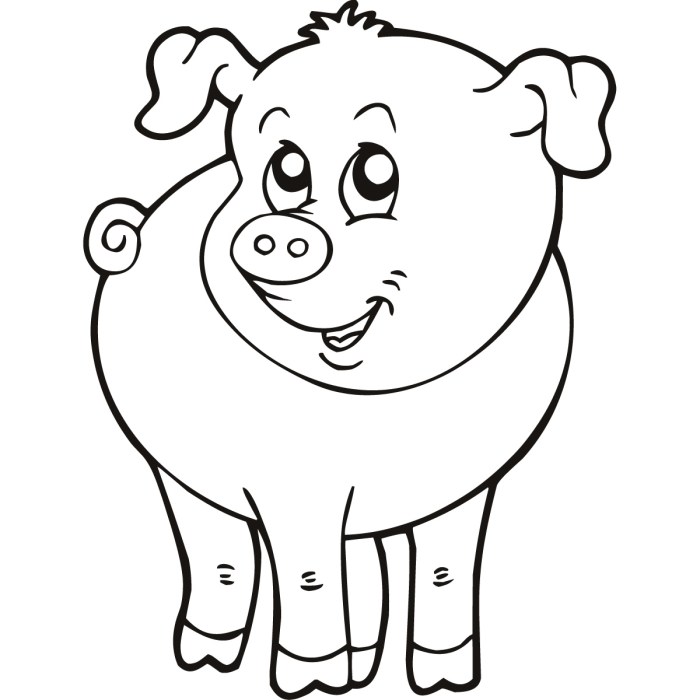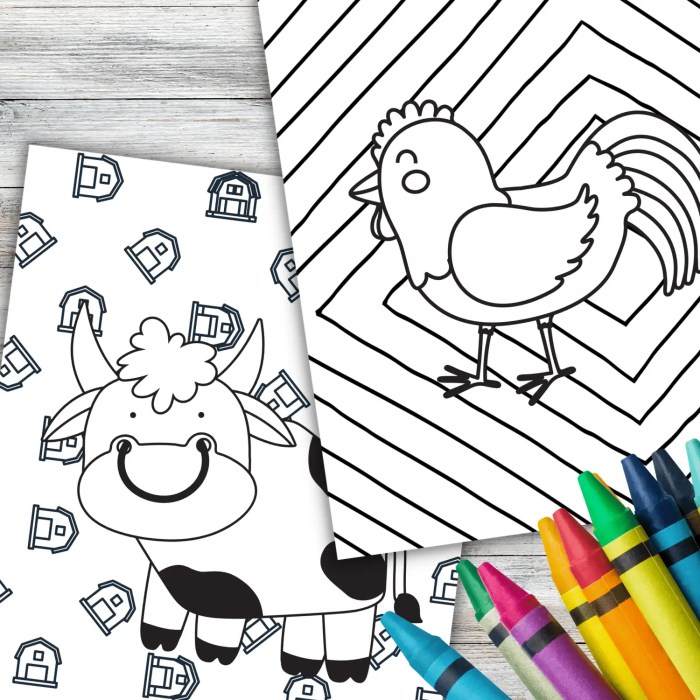Popular Barn Animals for Coloring Pages

Barn animals coloring pages – Coloring pages featuring barn animals are a popular choice for children, offering a fun way to learn about farm life and different animal species. These pages often depict animals in simple, recognizable poses, making them easy for young children to color.
Coloring pages featuring barn animals like cows and pigs are a classic activity. If you’re looking for something different, you might enjoy anime guy coloring pages for a change of pace. But there’s something undeniably charming about returning to the simplicity of coloring farm animals within a barn setting.
Common Barn Animals, Barn animals coloring pages
Commonly featured barn animals include horses, cows, pigs, sheep, chickens, and goats. These animals are staples of many farms and are easily identifiable by children due to their distinct features and frequent appearances in children’s books and media.
Less Common Barn Animals
While the aforementioned animals are frequently depicted, there are many other fascinating creatures that inhabit barns and contribute to farm life. Introducing children to these less common barn animals through coloring pages can expand their knowledge and appreciation for the diversity of farm animals.
| Name | Distinguishing Features | Habitat | Care |
|---|---|---|---|
| Peafowl | Males (peacocks) have extravagant, iridescent tail feathers; females (peahens) have more subdued plumage. | Originally from Asia, they are now found on farms worldwide, often in open areas with trees for roosting. | Require a spacious enclosure, a varied diet of grains, insects, and vegetables, and protection from predators. |
| Guinea Fowl | Round body, speckled gray feathers, and a distinctive, almost helmet-like casque on their head. | Native to Africa, they are now raised on farms globally, preferring areas with bushes and trees for shelter. | Need a secure enclosure, a diet of insects, seeds, and greens, and access to clean water. |
| Donkeys | Long ears, a stocky build, and a distinctive braying sound. | Originally from Africa, they are now found on farms worldwide, adapting well to various climates. | Require regular hoof care, a diet of hay and grains, and shelter from harsh weather. |
| Rabbits | Long ears, soft fur, and powerful hind legs for hopping. | While wild rabbits live in burrows, domesticated rabbits on farms are often housed in hutches or cages. | Need a clean and spacious living area, a diet of hay, pellets, and fresh vegetables, and regular veterinary check-ups. |
Age Appropriateness of Barn Animal Coloring Pages
Creating engaging and developmentally appropriate barn animal coloring pages requires careful consideration of the target age group. Different age groups have different skill levels and interests, which should be reflected in the design of the coloring page.The complexity of the coloring page plays a crucial role in a child’s motor skill development. Simpler designs benefit younger children developing fine motor control, while more intricate designs challenge older children and refine their existing skills.
Design Considerations for Different Age Groups
Toddlers and preschoolers (ages 2-5) benefit from coloring pages with large, simple shapes and thick lines. These features make it easier for them to stay within the lines and develop hand-eye coordination. Examples of suitable design elements include a simple Artikel of a cow with minimal details, a large, rounded pig, or a chick with basic shapes for its body and head.
These simpler designs allow young children to focus on the basic coloring activity without becoming overwhelmed. Older children (ages 6 and up) are ready for more complex designs with finer details and more intricate patterns. Examples include a horse with detailed mane and tail, a realistic depiction of a goat with textured fur, or a barn scene with multiple animals and background elements.
These more challenging designs encourage older children to refine their fine motor skills, improve precision, and explore their creativity.
Impact of Complexity on Motor Skill Development
The complexity of a coloring page directly influences a child’s motor skill development. For toddlers, simple Artikels and large shapes help them practice basic hand movements and control. As they color within the lines, they develop hand-eye coordination and improve their grip. As children grow, they can handle more complex designs. These intricate patterns and finer details challenge their fine motor control, encouraging more precise movements and better hand-eye coordination.
Coloring intricate designs also helps children develop patience and focus, as they need to concentrate on staying within the lines and completing the picture. For example, coloring a detailed picture of a sheep with textured wool helps a child refine their hand movements and improve their ability to control the coloring tool within smaller spaces.
Educational Value of Barn Animal Coloring Pages

Coloring pages offer a fun and engaging way to introduce children to the world of barn animals. Beyond simple entertainment, these pages can be valuable educational tools, fostering creativity while teaching children about different animal species, their characteristics, and their roles on a farm. The interactive nature of coloring encourages active learning and helps children retain information more effectively than passive observation.
Coloring pages can be used to teach children about different barn animals by providing a visual representation of each animal. This visual aid can help children learn to identify different species and distinguish their unique features. Discussions about the animals’ sizes, colors, and distinctive markings can enhance their understanding. For example, while coloring a pig, children can learn about its short legs, curly tail, and stout body.
Similarly, coloring a cow can help them identify its large size, four legs, and unique coat patterns.
Incorporating Learning Activities with Coloring
Learning activities can be combined with coloring to create a more enriching educational experience. These activities can reinforce the information learned through coloring and promote a deeper understanding of barn animals.
Matching animal names to pictures is a simple yet effective activity. Prepare flashcards with the names of different barn animals and have children match them to the corresponding coloring pages. This helps reinforce their recognition of animal names and their visual representations. Another engaging activity involves researching animal facts. After coloring a particular animal, children can research interesting facts about it, such as its diet, habitat, or lifespan.
This encourages independent learning and expands their knowledge beyond basic identification.
Lesson Plan: Barn Animal Habitats and Diets
This lesson plan utilizes barn animal coloring pages to teach children about the different habitats and diets of common barn animals.
The following lesson plan provides a structured approach to learning about barn animal habitats and diets using coloring pages as a central tool.
- Introduction (10 minutes): Begin by showing the children various barn animal coloring pages. Discuss the different animals depicted and ask the children what they already know about these animals.
- Coloring Activity (20 minutes): Distribute coloring pages featuring different barn animals, such as cows, pigs, chickens, horses, and sheep. Encourage children to color the animals realistically based on their natural colors and patterns.
- Habitat Discussion (15 minutes): After the coloring activity, discuss the concept of habitats. Explain that a habitat is the natural environment where an animal lives. Ask the children to think about where each of the barn animals they colored might live on a farm. Guide them to understand that cows and horses often live in pastures, pigs in pigpens, chickens in coops, and sheep in barns or fields.
- Diet Exploration (15 minutes): Introduce the concept of diet and explain that different animals eat different foods. Discuss the diets of the barn animals featured in the coloring pages. Explain that cows and sheep are herbivores and eat grass and hay. Pigs are omnivores and eat a variety of foods, including plants and small animals. Chickens are also omnivores, eating grains, insects, and worms.
Horses are herbivores, primarily eating grass and hay.
- Matching Activity (10 minutes): Prepare flashcards or cutouts depicting different food items (e.g., grass, hay, grains, insects, worms) and different habitats (e.g., pasture, pigpen, coop, barn). Ask children to match the food items to the correct animals and the habitats to the corresponding animals.
- Wrap-up (5 minutes): Review the key concepts learned during the lesson. Ask the children to recall the different habitats and diets of the barn animals discussed.
Promoting Inclusivity and Diversity in Barn Animal Coloring Pages: Barn Animals Coloring Pages

Coloring pages offer a fantastic opportunity to introduce children to the rich diversity of the animal kingdom. By showcasing a wide range of animal breeds and characteristics, including disabilities, we can foster empathy, understanding, and appreciation for the natural world’s variations. These seemingly simple coloring activities can contribute significantly to a child’s developing worldview, promoting inclusivity and challenging stereotypes.Representing diverse breeds and variations within barn animal coloring pages expands a child’s understanding of these familiar creatures.
It moves beyond the typical representations and encourages curiosity about the vast differences within each species.
Representing Different Breeds and Variations
Including various breeds of barn animals in coloring pages exposes children to the remarkable diversity within each species. For example, instead of just a generic “cow,” coloring pages can feature a Holstein, a Jersey, a Hereford, or even an Ankole-Watusi, each with distinct markings and characteristics. Similarly, chickens can be represented by breeds like the Rhode Island Red, Silkie, or Orpington, showcasing their varied plumage and body shapes.
This variety sparks curiosity and encourages children to learn more about the unique qualities of each breed.
Portraying Animals with Disabilities
Animals, like humans, can experience disabilities. Including animals with disabilities in coloring pages normalizes differences and fosters empathy in children. It challenges the idea of a “perfect” animal and encourages acceptance and understanding of all beings. This representation can also spark conversations about accessibility and the importance of caring for animals with special needs.
Examples of Inclusive Coloring Page Designs
Several approaches can be used to design coloring pages that celebrate diversity:
A coloring page featuring a three-legged chicken named Henrietta happily pecking at seeds. The caption reads, “Henrietta loves finding the tastiest seeds!” This example normalizes disability and presents it in a positive light.
A coloring page showcasing different breeds of pigs, including a Gloucestershire Old Spot, a Duroc, and a Kunekune. Each pig is labeled with its breed name, encouraging children to learn about the different varieties. The caption could read, “Pigs come in all shapes and sizes!” This example celebrates the variety within a single species.
A coloring page depicting a barn scene with a ramp leading to the hayloft, allowing a goat with a wheeled cart for its back legs to access it alongside other goats. The caption could read, “All animals are welcome in the barn!” This example highlights accessibility and inclusion.
